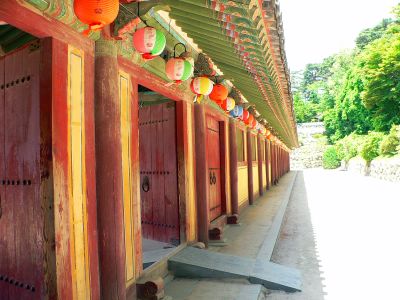Friday, June 03, 2005
Korea 200505i: Roof support
Colourful roof support, comprising interlocking wooden blocks which fit each other snugly to hold the roof, so no nails needed. The colourful pattern lacks yellow, probably a colour reserved for royalty, as the case is with China. In Japan such design will only have black and white - a minimalist design?
Korea 200505h: Courtyard of Daeungjeon
This is the courtyard of Daeungjeon, the most scacred hall in the complex. Here lie two stone pagodas - Dabotap and Seokgatap. Both are native Korean design dating from the 8th century.
The Bulguksa Temple was pillaged by Japanese invaders in the 16th century, but was restored in the last century, during the Japanese occupation and during Park Chung-Hee's rule. Hmmmm...no wonder it's almost impossible to spot Japanese cars in Korean streets.
The Bulguksa Temple was pillaged by Japanese invaders in the 16th century, but was restored in the last century, during the Japanese occupation and during Park Chung-Hee's rule. Hmmmm...no wonder it's almost impossible to spot Japanese cars in Korean streets.
Korea 200505g: Entering Bulguksa
Bulguksa is a complex of temples and other buldings, interlinked with a network of covered walkways. It is built on the hill-side, hence exploring the area involves going up and down steep stone staircases. Not recommended with a heavy pack on your back.
Korea 200505f: Cleansing
In my temple visits in Japan and China, there is always running water for visitors to cleanse themselves before entering the temple compound, and there is no exception here. Near the path leading up to Bulguksa, fresh clean water flows from the ground into a ancient stone tub. It has been around for centuries, and like fellow disciples, I wash my hands and face, and consume some. It tastes just like bottled mineral water and is very refreshing.
Now I'm ready for a temple walkabout...if only I can get rid of my backpack! :-(
Now I'm ready for a temple walkabout...if only I can get rid of my backpack! :-(
Korea 200505e: Bulguksa at last!
A few minutes after passing the gate with the colourful ogres, I arrive at a clearing and come face-to-face with the 1,500-year old temple itself - Bulguksa. The stone facade and staircases of the temple entrance are weatherbeaten but sturdy nevertheless.
Beyond the entrance lie three sacred halls, each representing the three ideal lands of Buddha:
- Daeungjeon Hall: refers to Sakyamuni or Buddha's Land
- Geungnakjeon Hall: refers to Amitabha's Paradise Land
- Birojeon Hall: refers to Buddha Birojana's Land of Truth
The entrances via the staircases have been blocked (I think to preserve the ancient steps from trampling feet), so visitors must enter the temple area via an uphill path to the right of the structure. I make my way there...
Beyond the entrance lie three sacred halls, each representing the three ideal lands of Buddha:
- Daeungjeon Hall: refers to Sakyamuni or Buddha's Land
- Geungnakjeon Hall: refers to Amitabha's Paradise Land
- Birojeon Hall: refers to Buddha Birojana's Land of Truth
The entrances via the staircases have been blocked (I think to preserve the ancient steps from trampling feet), so visitors must enter the temple area via an uphill path to the right of the structure. I make my way there...



















